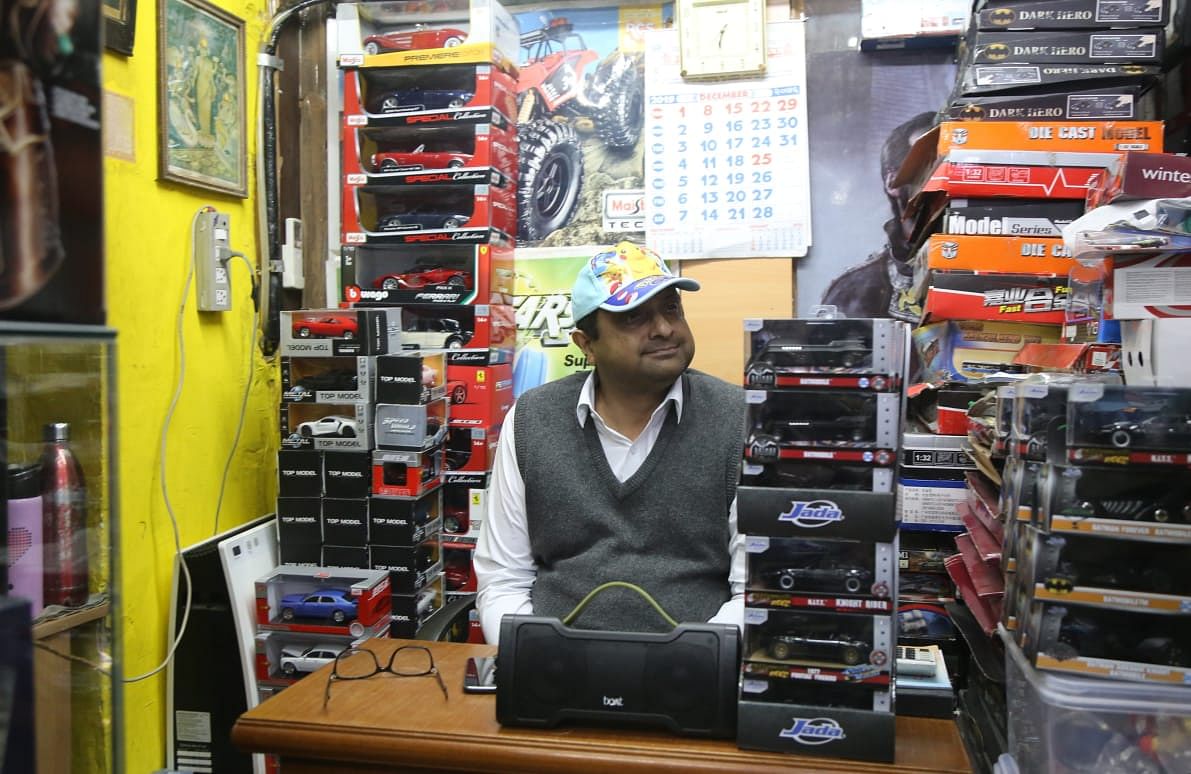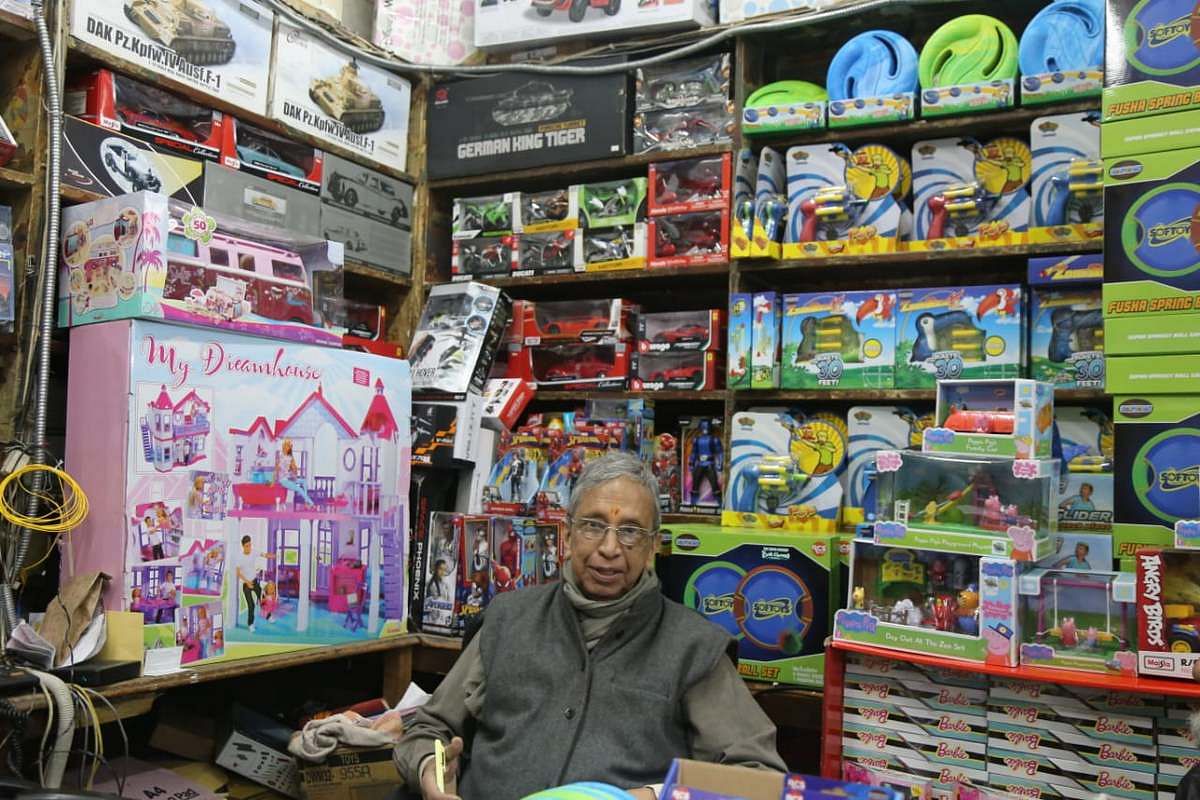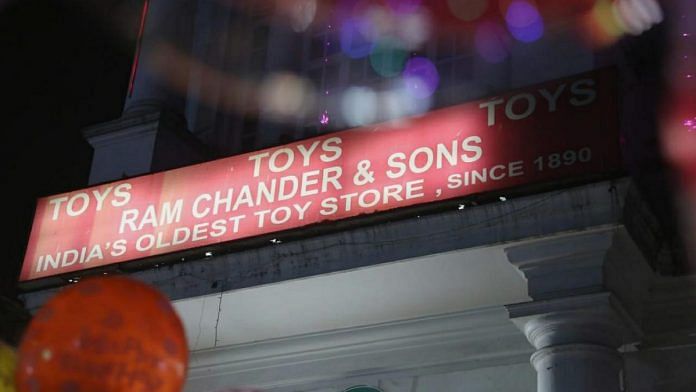New Delhi: It would be easy to miss Ram Chander & Sons. The narrow shop entrance forms a nondescript corner of Connaught Place’s Odeon Building in the national capital, overshadowed by Croma, Social and Smoke House Deli. But you can’t miss the crowds of people in and around the shop.
Some gaze at the toys displayed in the window, some drag their parents into it, some, having just exited, wave goodbye to its owner, their arms laden with airplane model kits, boxes of Avengers and Peppa Pig figures and toy cars.
I’m sitting inside the store with Amit Sundra, who runs it with his father, Satish. We’re in a cramped corner of the shop, where a small desk is piled high with files and papers; there’s just enough space for the cup of tea he has had made for me, and for the small stereo out of which flute music wafts.

“I like music very much, in fact I was a music critic,” Amit tells me. “After I graduated with a degree in English from St. Stephens (where his father studied history in his day), when HT City was launched, I used to handle the music, then I wrote for a bunch of other publications as well. I took a break to focus on my book, but I haven’t finished it. Also I’ve had this eye problem for a few years and can’t see very much. I tried some voice softwares, but couldn’t really adjust. I prefer to write with ink and paper. I’m an old-school chap.”
Old-school is a word he uses a lot, especially when talking about what he proudly tells people is “the oldest toy shop in India”, in case you missed the detail on the signage outside. While Amit’s grandfather, Raj Sundra, started the CP shop in 1932, the family’s toy shop has actually existed since 1890, when the family’s then patriarch, Seth Chunnilal, decided Ambala could do with some fun and games.
Historically, Ambala was an important city and it had a fair amount of British influence, explains Amit. Until Independence, the shop got by on essentially British patronage — they would buy toys for their kids, especially for Christmas. The family opened a Kasauli franchise a couple of decades later, and would shut the Ambala shop for the summer and move to Kasauli because the British would head to the hills — “it was like our own version of a summer and winter capital,” he laughs.
But in the early 1930s, Raj Sundra realised that Delhi would be the next big thing, and Connaught Place was its upcoming market project. Lutyens’ Delhi was coming up, bungalows were being built and CP had a whole bunch of empty commercial spaces going at inexpensive rates. And so, in 1932, Delhi became the home of Ram Chander & Sons.

History through toys and games
In the heart of the capital, close to the residences of civil servants, politicians and judges, the Supreme Court and the Delhi High Court, North Block, South Block and Parliament House, the Delhi shop has been a go-to for everyone from the Gandhis to the Pataudis.
In a sense, the store and its toys is a symbol of Delhi, a lens through which to see glimpses of the city’s history. Amit recalls that in the 70s, when he was a student of St. Columba’s school, “all this fancy stuff wasn’t there. Imported toys used to come from Japan, London, Hong Kong, but we imported maybe 40 per cent of our toys; the majority was domestically made. But today Indian toys make up not more than 10 per cent of our collection.”
Earlier, he says, there were thousands of Indian toy makers and small cottage industries. “We handpicked the products: wooden crafts, tin soldiers, rubber and plastic toys, clay dolls. But in the ‘80s, when Delhi was to host the Asian Games, colour TV came in, then VCR and English movies and that started to change things.
“With greater exposure, we were starting to expect better quality. But when the need of the hour was to learn, adapt and improve, most manufacturers shut down because they were either unable or unwilling to. They wanted to keep selling the same old stuff even though incomes had gone up and people were spending more, travelling more.”
Amit also laughs that now, “All the politicians and bureaucrats who come are far better behaved than they were. Maybe given social media and how easy it is to shame someone, they are more on their guard and keep a lower profile. They used to be a bunch of bloody hooligans!”
He recalls an incident during the Emergency, when a civil servant entered the shop and tried to make Amit’s seven-months pregnant aunt get up and give him her chair. “He threatened that he would have the shop shut. Luckily, his senior was also in the shop and took him to task.”
Also read: Now online — where to find rare journals and articles from British-ruled India
Partition, the 1984 riots and the mess of the Commonwealth Games
Given that the store was launched in Delhi just a few years before Indian independence in 1947, it is not inconceivable that the Sundra family was impacted. Amit has, of course, only heard stories from his parents. “You see, in the toy business, Christmas is the main target — not Diwali or any other festival. My grandfather would start planning for it in January itself — because slow ships would bring consignments.
“Before Partition, Karachi was the biggest port for undivided India. And then in 1947, all hell broke loose. My grandfather had Rs 2 lakh worth of toys stuck at the port, and he was reduced to a couple of shirts and pairs of trousers. He never got it back — that stress also led, I think, to his untimely passing.”
He recounts how, his grandmother, father, uncle and three aunts were locked in the shop (half of which was also their house) for three days with no food or water. On the fourth day, his grandmother went to what was then Odeon Sweet House and bought some two-day old barfi at a crazy price — that was the first food they had.
“The shop did open after 10-12 days but business was slow. Many of us struggled to get back on our feet — for about a year. You were not sure where you could buy your next meal from. And Rs 2 lakh was a hell of a lot of money.
“Honestly, nothing compares to the horrors I hear about Partition — maybe the ’84 anti-Sikh riots, although that was for a little while. The shop was shut for 10 days, school was shut, food was available, but exorbitant. I saw a lot of shops around here completely ablaze. I saw mobs in action. My neighbours ran away. Things returned to normal after maybe a month,” says Amit.
The other time Ram Chander & Sons was really impacted was not during a riot or a war, but the Commonwealth Games. Delhi residents will remember how, for a few years, CP was completely dug up for renovation before the Games — except that the project went way past its deadline. “That was a bad time,” says Amit, shaking his head. “The whole of CP was a mess for so long — who the hell wanted to come?”
He found a way to entertain those who did venture there, though. “I used to take out my monster truck and drive it up and down — it was like a demo of a toy in a demolition site, and people used to like that. That was our innovation.”
Also read: In the age of Putin’s Russia, George Orwell’s 1984 is stiflingly relatable today
Keeping up with the Hamley’s
Innovation brings me to my next question. Post globalisation, how does a store like Ram Chander keep up with malls, globally renowned brands like Hamley’s, with PlayStations and apps?
“You have to assess your strengths and weaknesses. For example, I’m under a lot of pressure from one set of people to change the decor of my shop, because there’s nothing modern or fancy about it. This floor is from the 1930s, and there have been plenty of occasions when foreigners have come here and tried to scrape off a little paint from the walls,” says Amit.
“If I want to renovate, I have to apply to multiple ministries and departments, because this is a heritage zone. But you see under those tank boxes, the grey boxes contain Rolls-Royce models, which cost 16 grand each. Now, a lot of stores may be five times the size of mine, but they won’t have these. These model kits are what we’re known for — cars, airplanes, boats, submarines. For these, you have to come to Ram Chander & Sons. They’re manufactured by British and German companies, but we have the rights for India,” he adds.
Amit gets up to show me a model of an aircraft — you stick the pieces together, paint them, transfer decals — the works. It’s an exact scale, he says proudly.
Amit is honest about the fact that sales are down. “Profits for this year are half of last year’s. We’re feeling the full impact of the economic slowdown, and we’ve been feeling it since demonetisation in 2016.”
One reason the store is able to retain its loyal customer base is its wide price range, from Rs 100 for a small car or stationery to Rs 65,000 for some of the model kits. And the fact that the store ships to 64 countries. “It’s a case study for Google — and three years ago, we were invited to meet (tech giant’s CEO) Sunder Pichai. My company represents other companies in India.”
‘Happiness on a child’s face’
Amit leaves me for a few minutes to go see to some customers and tells a young kid “Beta, sweater pehno”. Then he gets pulled into a conversation with some parents about the merits of a particular toy, and this eventually turns into a long debate about politics.
I don’t mind the delay, because it gives me time to wander about the store and browse its collection. There are jigsaw puzzles, Barbie dolls, little models of cars and boats crammed together with superhero figures, numbers games, tanks and fighter planes. There doesn’t seem to be the usual gender segregation one sees in toy stores.
When Amit returns, I ask him about this — the sexist messaging that the toy industry often gives out. “Honestly, it’s a marketing gimmick for the toy companies, and it comes from America — this pink and blue nonsense — and we love to copy the West.”
But, he is quick to add, he has seen a huge change in this mindset in the last few years. “There’s an increasing number of parents who don’t give a s**t. Lots of boys play with kitchen sets, particularly after shows like MasterChef have come in, and I can recall at least five or six instances when a little boy has cooked something for me and brought it for me or my dad to eat. I often tell parents chill out, there’s nothing wrong with a boy wanting a kitchen set.
“But the girl-boy divide won’t go away because it makes it easier for companies. For them, Frozen is for girls, Iron Man for boys. But I’ve seen many older girls come into the shop who are genuine Iron Man fans. Why his origin story is so much more interesting than Captain America’s, why they think he’s a tragic hero — they have all these debates.”
Given that Odeon (Carnival Cinemas) is right there, I wonder if the store ever partners with the theatre, say for a big Avengers or Batman release. Amit emphatically says no.
“We do a window display for Christmas and thematic windows, like when Avengers: Endgame was released (in May). But I would not like to go and set up a stall, even at Odeon. I like to sell from here, I like to meet my customers, chat with them, get to know them. I want to see the happiness on a child’s face, hear the parents grumble about the number of toys the kid wants.
“I love it when kids come and touch the toys, open the packaging, test out a toy. Many places don’t allow this, but I have no such issues. If a child cannot play with a toy in a toy shop, then what’s the point of the shop?”
Also read: Disney bets on nostalgia to win back ‘Star Wars’ fans






